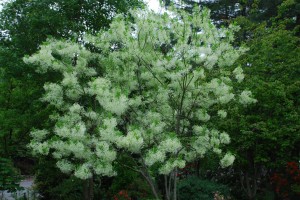American fringetree (Chionanthus virginicus) is one of the finest spring flowering trees (USDA hardiness zones 4-9). Individual flower heads are large and billowy, snowy white, and very fragrant in the early evening hours. Flower panicles peak through the large leaves, and are large and showy compared to Chinese fringetree (which I also like).
Leaf sizes range from 3 to 10 inches in length and exhibit a high-gloss upper surface. Fringetrees rate above average disease and insect resistance. Seedling forms are quite variable in summer leaf colors (medium to dark green) and in fall leaf color (pale green, yellow, and brown). On occasion, individual fringetrees surprise with sensational autumn color.
In its early years plants start off slowly. Shoot growth may be wild and require pruning attention. Shrubs can be trained into 1 to 3 trunk trees through judicious annual pruning. Remove most, if not all basal suckers during the first 3-4 years. Staking may be required the first 1-2 years to develop a strong leader(s).
American fringetree is dioecious; male flowers are non-fruiting, while female flowers bear ½ inch long egg-shaped blue-black fruits (drupes). Seeds collected and sown in the fall germinate 2-3 years later. ‘Emerald Knight’, a male form, exhibits slightly upright branching and dark green leaves. Reportedly, ‘Emerald Knight’ may be propagated vegetatively.
American fringetree prefers full sun but grows okay in light shade with less flowers. Plant in a wide range of soils that are well-drained and lightly acidic. A 3 to 5 gallon plant will grow to 25 to 30 feet tall and wide in 20 years. Keep newly planted shrubs lightly mulched and irrigated. Two-year established plants demonstrate good drought tolerance. In southern climes fringetree performs better sited under light afternoon shade.
Caveat: People often confuse the name “fringetree” (Chionanthus) with “fringe flower” (Loropetalum)


 Posted in
Posted in 
